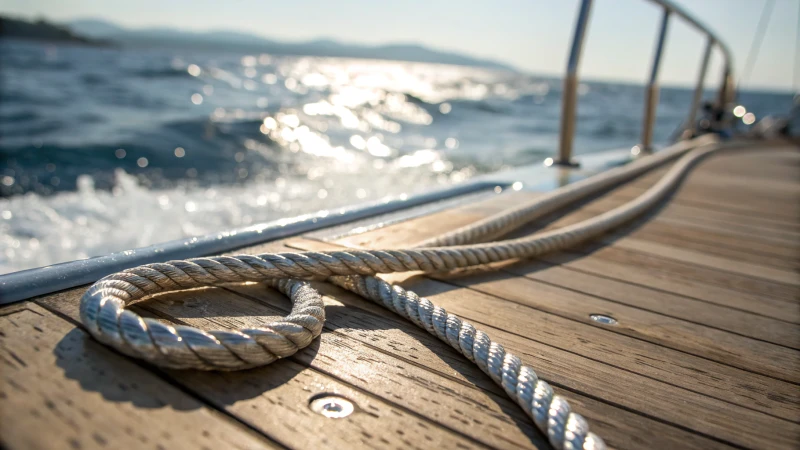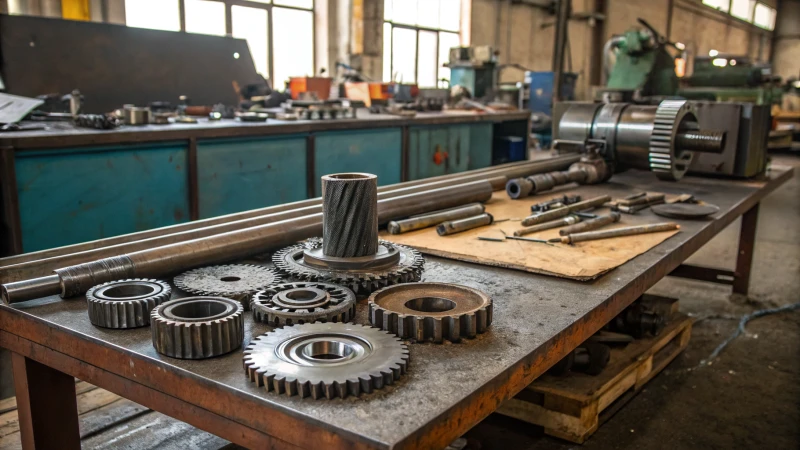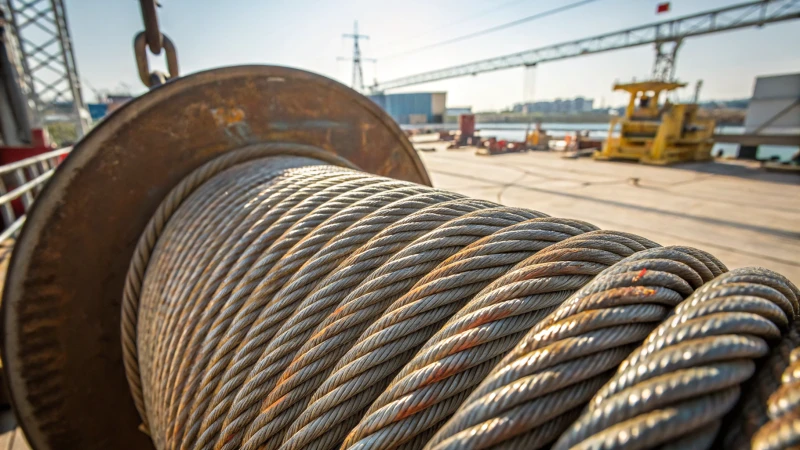
Imagine selecting the wrong material for a steel wire rope and facing catastrophic failure on a construction site.
Choosing the right material for steel wire rope is crucial as it directly affects its tensile strength, corrosion resistance, and fatigue durability. High-carbon steel provides exceptional strength, stainless steel excels in resisting corrosion, and alloyed steels enhance fatigue resistance, making them ideal for various industrial needs.
I remember the first time I had to decide on materials for a major project. The stakes were high, and my decision would impact not just timelines, but safety and cost. Each type of steel offered different benefits: high-carbon steel's robustness seemed perfect for heavy-duty tasks, while stainless steel's resistance to rust made it a must for marine environments. Exploring these materials' distinct properties gave me insights into meeting unique industry demands. Let's dive into these nuances, ensuring your choices align with your project's specific needs.
High-carbon steel ropes offer superior tensile strength.True
High-carbon steel is known for its excellent tensile strength, making it ideal for heavy-duty applications.
Stainless steel ropes lack corrosion resistance.False
Stainless steel is specifically chosen for its high corrosion resistance, especially in marine environments.
What Makes High-Carbon Steel Ideal for Wire Ropes?
Ever wondered why high-carbon steel is the go-to for wire ropes in heavy-duty work? It’s all about strength, durability, and a touch of engineering magic!
High-carbon steel in wire ropes boasts remarkable tensile strength, durability, and wear resistance, making it perfect for demanding tasks like construction, mining, and industrial lifting.

Tensile Strength and Durability
Back when I first got involved in the world of construction procurement, understanding tensile strength felt like deciphering a secret code. But as I dug deeper, I realized that high-carbon steel's exceptional tensile strength1 was the unsung hero in our projects. With a carbon content between 0.6% and 1.0%, this steel transforms into something hard and resilient, ready to take on immense forces without flinching. It’s this very quality that makes wire ropes from high-carbon steel indispensable in industries like construction2 and mining. I've seen these ropes carry the weight of entire structures with a grace that still amazes me.
Wear Resistance
Another aspect that makes high-carbon steel a favorite is its stellar wear resistance. Imagine ropes that can withstand constant friction and abrasion without losing their edge—literally. This is crucial for equipment like cranes and hoists that see heavy use daily. I remember one project where switching to high-carbon steel ropes drastically cut down our replacement frequency, saving us both time and headaches.
Flexibility vs. Rigidity
Initially, I thought flexibility and rigidity were polar opposites that could never coexist. But high-carbon steel taught me otherwise. Manufacturers have perfected the art of balancing these traits, tweaking carbon levels and employing advanced techniques to ensure the ropes remain tough yet flexible enough to function effectively.
| Property | Description |
|---|---|
| Tensile Strength | The ability to resist breaking under tension, crucial for heavy lifting tasks. |
| Durability | Long-lasting performance even in harsh environments, reducing replacement frequency. |
| Wear Resistance | Protection against surface damage from friction, enhancing rope lifespan. |
Applications in Heavy-Duty Industries
From my experience, high-carbon steel's impressive properties make it a staple in sectors where strength isn't just preferred—it’s mandatory. Whether it's mining operations or large-scale construction projects, these ropes are the backbone of heavy-duty lifting3 operations. Ensuring they meet stringent quality standards and pass rigorous tests has always been non-negotiable for us because safety is paramount. Every time I see those ropes in action, I can't help but feel a sense of pride knowing we've made the best choice for our needs.
High-carbon steel wire ropes have high tensile strength.True
High carbon content enhances tensile strength, crucial for heavy-duty use.
High-carbon steel wire ropes lack wear resistance.False
The high carbon content actually improves wear resistance, not reduces it.
Why Choose Stainless Steel Wire Ropes for Marine Use?
Ever stood at the edge of a ship, gazing at the endless blue, wondering how it all holds together? Stainless steel wire ropes are the unsung heroes of the seas.
Stainless steel wire ropes excel in marine environments due to their exceptional corrosion resistance, tensile strength, and durability. These attributes ensure long-lasting performance, vital for maritime tasks where reliability is paramount.

My Journey with Stainless Steel in Marine Settings
I remember my first trip on a fishing vessel as if it were yesterday. The salty breeze against my face and the rhythmic creaking of ropes became part of the adventure. I learned quickly that these ropes were no ordinary material; they were the lifelines keeping everything secure. In marine environments, corrosion is an unyielding foe. But stainless steel4 wire ropes, with their high chromium content, fight back valiantly, forming a protective layer that keeps rust at bay.
Moreover, stainless steel doesn't lose its cool under pressure—literally. It maintains its mechanical properties even when temperatures soar, which is a big plus when dealing with unpredictable marine climates.
Comparing Materials: My Experience with Stainless Steel vs. Alternatives
I've tried my hand at different materials over the years. Galvanized steel offers some defense against corrosion but can't compete with the enduring resilience5 of stainless steel.
| Material | Advantages |
|---|---|
| Galvanized Steel | Some corrosion resistance |
| Synthetic Ropes | Lightweight |
| Stainless Steel | High strength and abrasion resistance |
As for synthetic ropes? They're light, sure, but lack the necessary strength and abrasion resistance for many marine tasks. For me, stainless steel remains my go-to choice for heavy-duty6 operations.
Real-World Applications in Marine Industries
In my time working with shipping and fishing companies, stainless steel wire ropes have proven indispensable. They're essential for:
- Mooring lines
- Fishing gear
- Cargo handling equipment
Each application demands ropes that endure tension, flexing, and exposure to the elements. With stainless steel ropes, safety and efficiency aren't just buzzwords—they're assured. For instance, fishing vessels7 rely heavily on these ropes to keep nets intact over long sea voyages. Their resistance to corrosive seawater effects is what keeps operations smooth and maintenance downtime minimal.
Technical Tips for Procurement Decisions
When sourcing stainless steel, knowing your grades can make all the difference.
| Grade | Property |
|---|---|
| AISI 304 | General corrosion resistance |
| AISI 316 | Superior resistance8 to pitting |
Grades like AISI 316 offer superior resistance to pitting and crevice corrosion, which is perfect for harsh marine conditions. Selecting the right grade impacts not only your upfront costs but also future maintenance expenses—investing wisely often means saving in the long run.
Choosing a higher-grade stainless steel might seem pricey initially, but trust me—it pays off by reducing repair and replacement needs down the line. In the end, it's all about ensuring your operations are not just running but thriving.
Stainless steel wire ropes resist corrosion in saltwater.True
Stainless steel's chromium forms a passive layer, preventing rust.
Synthetic ropes are stronger than stainless steel ropes.False
Synthetic ropes lack the strength and abrasion resistance of stainless steel.
Why Are Alloyed Steels Preferred for Industrial Applications?
I remember the first time I truly understood why alloyed steels are such a big deal in industrial applications. It was during a challenging construction project where the strength and reliability of materials were tested daily.
Alloyed steels are preferred in industrial applications for their superior strength, corrosion resistance, and durability compared to plain carbon steels. These enhanced properties make them ideal for demanding environments.

Properties of Alloyed Steels
When I first encountered alloyed steels, I was amazed by how a few added elements could transform ordinary steel into a powerhouse of performance. These steels are a unique blend of carbon steel with elements like chromium, nickel, or manganese. I once worked on a project where the tensile strength of these steels saved us from potential disaster. Their ability to withstand immense forces without deforming is truly remarkable.
- Strength: Alloyed steels9 exhibit higher tensile strength, allowing them to withstand greater forces without deforming.
- Corrosion Resistance: Elements like chromium provide excellent resistance to rust, making these steels suitable for use in corrosive environments10.
- Durability: They offer better fatigue resistance, essential for applications involving repetitive stress.
| Property | Plain Carbon Steel | Alloyed Steel |
|---|---|---|
| Tensile Strength | Moderate | High |
| Corrosion Resistance | Low | High |
| Fatigue Resistance | Moderate | High |
Applications in Various Industries
In the construction industry, I've seen alloyed steels become the backbone of projects. From skyscrapers that pierce the sky to bridges that span mighty rivers, these steels bear heavy loads and resist environmental wear like no other. I recall a particular bridge project where their strength and resilience were critical.
Construction Industry
Alloyed steels are extensively used in construction due to their ability to bear heavy loads and resist environmental wear. For example, bridges and skyscrapers utilize these steels for structural integrity.
The mining industry is another realm where these steels shine. Equipment like drills and loaders face relentless abuse, and chromium-manganese steel11 is often our go-to due to its exceptional hardness and wear resistance.
Mining Industry
In mining, equipment such as drills and loaders require materials that can withstand harsh conditions. Chromium-manganese steel is commonly used because of its exceptional hardness and wear resistance.
In heavy machinery manufacturing, alloyed steels are essential. I've worked with gears and shafts that must endure significant stress, and these materials ensure performance remains uncompromised.
Heavy Machinery
Alloyed steels are crucial in manufacturing parts for heavy machinery. Their strength and durability ensure that components like gears and shafts maintain performance under significant stress.
Understanding Alloy Composition
One thing I've learned is that the specific composition of alloyed steels determines their suitability for different applications. For instance:
- Chromium: Enhances corrosion resistance and hardenability.
- Nickel: Adds toughness and improves impact strength.
- Manganese: Increases wear resistance and tensile strength.
The following table illustrates typical alloy compositions:
| Element | Percentage Range (%) |
|---|---|
| Chromium | 10-30 |
| Nickel | 3-15 |
| Manganese | 1-10 |
These compositions12 make alloyed steels versatile and adaptable to specific needs, offering solutions across various sectors. The balance of elements can be adjusted to meet the requirements of different industrial applications.
Alloyed steels have higher tensile strength than carbon steels.True
Alloyed steels are enhanced with elements like chromium, increasing tensile strength.
Plain carbon steel offers better corrosion resistance than alloyed steel.False
Alloyed steels include elements like chromium, which enhance corrosion resistance.
What makes composite materials a game-changer for steel wire ropes?
Curious about how composite materials can supercharge steel wire ropes? Let me share why these innovative materials are making waves in various industries.
Composite materials in steel wire ropes deliver exceptional strength-to-weight ratios, increased corrosion resistance, and enhanced flexibility. These advantages make them perfect for demanding sectors like construction and marine engineering, where durability and performance can't be compromised.

Enhanced Strength-to-Weight Ratio
Let me tell you a little story from my early days in construction procurement. I remember standing on a high-rise building site, wrestling with bulky, traditional steel wire ropes. They were heavy, cumbersome, and frankly, a bit of a nightmare to handle. That's when I first learned about composite materials. By incorporating something like carbon fiber, these ropes became stronger yet so much lighter. Suddenly, the back-breaking labor of handling them transformed into a more manageable task.
For industries where every ounce counts—think aerospace or those towering skyscrapers—lighter ropes mean not just less strain on the team but also lower operational costs. It's a win-win! For more details on this enhanced strength-to-weight ratio13, check out additional resources.
Superior Corrosion Resistance
Imagine this: you're out at sea, the salty air whipping around, and all you can think about is whether your equipment will survive the harsh conditions. I've been there, worrying about traditional steel ropes rusting away. But with composite materials, that's less of a worry. These materials offer superb resistance to corrosion. In sectors like marine engineering or offshore drilling, where the ropes are perpetually exposed to corrosive elements, using composites means longer-lasting equipment and fewer replacements.
This resistance ensures that ropes maintain their integrity and performance over time. Learn more about exposure to corrosive environments14 and how composites can help.
Improved Flexibility and Fatigue Resistance
Flexibility might seem trivial until you see a traditional rope snap under pressure—or worse, on the job. Back when I was involved in mining operations, I witnessed firsthand how inflexible ropes could lead to costly downtime. Composites change that narrative with their superior flexibility and fatigue resistance. They can handle repeated strain without losing their integrity, making them invaluable in demanding fields like mining or heavy lifting.
These materials offer superior flexibility15 compared to standard steel wires.
Comparative Overview
| Material | Strength-to-Weight | Corrosion Resistance | Flexibility |
|---|---|---|---|
| Traditional Steel | Moderate | Low | Limited |
| Composite-Enhanced | High | High | Superior |
Looking at this table, it's clear that composite materials aren't just an upgrade; they're a revolution. For anyone in industries where efficiency and reliability are non-negotiable, choosing composite-enhanced ropes is like choosing the future.
If you're keen to explore more detailed comparisons and case studies, I recommend checking out resources on industrial applications16. They offer great insights into how these materials are shaping the industry.
Composite materials improve steel ropes' strength-to-weight ratio.True
Composite materials like carbon fiber enhance strength while reducing weight.
Traditional steel ropes offer better corrosion resistance than composites.False
Composites provide superior corrosion resistance compared to traditional steel.
Conclusion
Material selection for steel wire ropes is vital, influencing strength, corrosion resistance, and durability. High-carbon, stainless, alloyed steels, and composites each offer unique benefits for various applications.
-
Understanding tensile strength helps in selecting materials that won't fail under pressure. ↩
-
Learn how high-carbon steel is utilized in building projects for enhanced safety. ↩
-
Discover the importance of using robust materials in lifting operations. ↩
-
Discover how stainless steel's unique properties benefit marine applications, ensuring durability and resistance to harsh conditions. ↩
-
Understand why stainless steel surpasses galvanized steel in resisting corrosion and maintaining integrity in marine conditions. ↩
-
Learn about the specific marine applications where stainless steel wire ropes excel, providing strength and reliability. ↩
-
Explore how fishing industries benefit from using stainless steel ropes to ensure longevity and reduce maintenance costs. ↩
-
Find out why AISI 316 is preferred over AISI 304 for superior corrosion resistance in challenging marine environments. ↩
-
Discover how additional elements enhance the strength of alloyed steels, making them suitable for heavy-duty applications. ↩
-
Learn how chromium prevents rust and prolongs the lifespan of steel products in harsh environments. ↩
-
Explore why this specific alloy is favored in mining for its hardness and wear resistance. ↩
-
Understand how varying compositions alter steel characteristics, tailoring them for specific industrial needs. ↩
-
Understanding this can highlight why composite materials enhance efficiency in weight-sensitive applications. ↩
-
This will explain how composites improve durability in harsh environments. ↩
-
This helps understand how flexibility benefits specific industries. ↩
-
This offers real-world examples of benefits seen with composite materials. ↩

